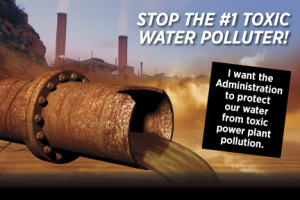
By Jennifer Peters, National Water Programs Director - Follow Jennifer on Twitter (@EarthAvenger)
It’s National Public Health Week, which has me thinking about the importance of clean water. Nothing is more basic to protecting public health than access to clean and safe water for drinking, sanitation, and cooking. But too often the streams, rivers or lakes that are sources of drinking water are also used by polluting industries upstream to dispose of their waste. This was an even bigger problem before Congress passed the Clean Water Act in 1972, the law that protects our nation’s surface water resources. But in 2015, in the United States, there are some industries that still dump unlimited amounts of toxic pollutants directly into our precious water resources.
One industry that still pollutes our water with its waste is the power plant industry. It’s no secret that coal-burning power plants are one of the worst air polluters. Their emissions are known to cause respiratory illnesses and numerous other serious health effects. What is not as well-known is that these same plants are also the worst toxic water polluters.
Every year, coal-burning power plants dump an estimated 5.5 billion pounds of pollution, including arsenic, mercury, lead and other pollutants that are known to pose serious health risks when present in the water we drink or in the fish that we eat. Clean Water Action released this white paper in 2013 that highlights four specific drinking water contaminants of concern that are commonly found in power plant wastewater.
According to the U.S. Environmental Protection Agency (EPA) coal-burning power plants are responsible for more than half of all toxic water pollution in the country – more than all incinerators oil refineries, paper mills and petrochemical plants combined. This fall, EPA will finalize the first ever standards to limit heavy metals, nutrients and other contaminants that are present in power plant wastewater. The public health benefits of reducing toxic metal and nutrient pollution in surface waters are huge. They include avoided cancer cases from arsenic exposure, avoided IQ losses in children from mercury and lead exposure, and reduced cases of other non-cancer health effects.
Until new standards are put in place to eliminate or drastically reduce toxic water pollution coming from power plants, downstream water utilities will continue to bear the burden of removing harmful pollutants from their source waters in order to deliver clean water to consumers. EPA has proposed strong standards that would eliminate virtually all of this toxic pollution, but the power plant industry is pressuring the Administration to weaken them.
Americans need clean water – not higher profits for an industry that continues to pass on the cost and burden of cleaning up its toxic mess on downstream communities. You can learn more about Clean Water Action’s campaign to end toxic power plant water pollution here.
The referenced media source is missing and needs to be re-embedded.
Stop Toxic Power Plant Water Pollution!Related Posts
Stay Informed
Get the latest updates and actions:
Thanks for signing up!
There was a problem processing your signup. Please try again.


